MITSUBISHI LANCER EVOLUTION IX 2005 Service Manual
Manufacturer: MITSUBISHI, Model Year: 2005, Model line: LANCER EVOLUTION IX, Model: MITSUBISHI LANCER EVOLUTION IX 2005Pages: 364, PDF Size: 14.38 MB
Page 41 of 364
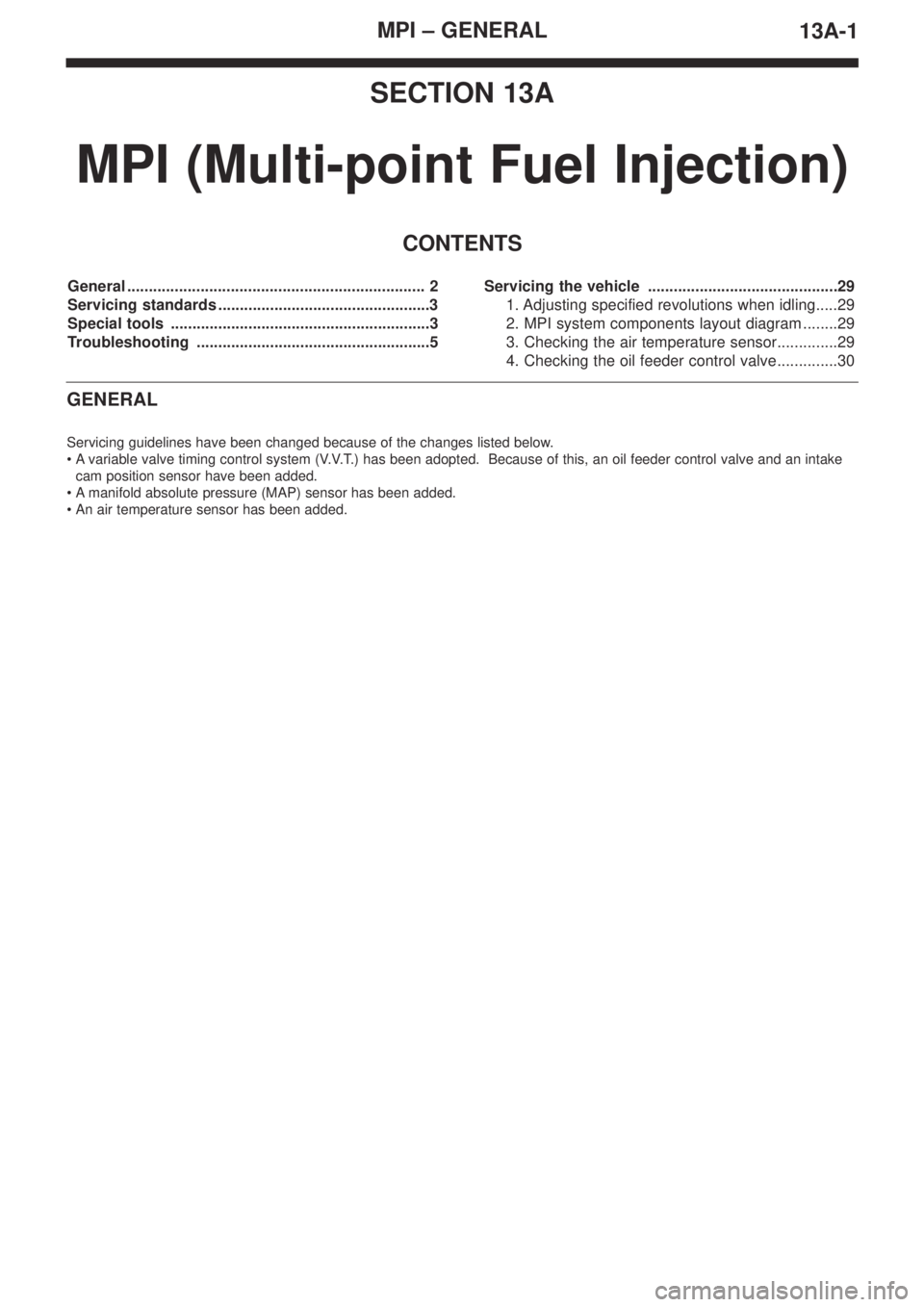
MPI – GENERAL
13A-1
SECTION 13A
MPI (Multi-point Fuel Injection)
CONTENTS
General ..................................................................... 2
Servicing standards .................................................3
Special tools ............................................................3
Troubleshooting ......................................................5Servicing the vehicle ............................................29
1. Adjusting specified revolutions when idling.....29
2. MPI system components layout diagram ........29
3. Checking the air temperature sensor..............29
4. Checking the oil feeder control valve..............30
GENERAL
Servicing guidelines have been changed because of the changes listed below.
•Avariable valve timing control system (V.V.T.) has been adopted. Because of this, an oil feeder control valve and an intake
cam position sensor have been added.
•Amanifold absolute pressure (MAP) sensor has been added.
•An air temperature sensor has been added.
Page 42 of 364
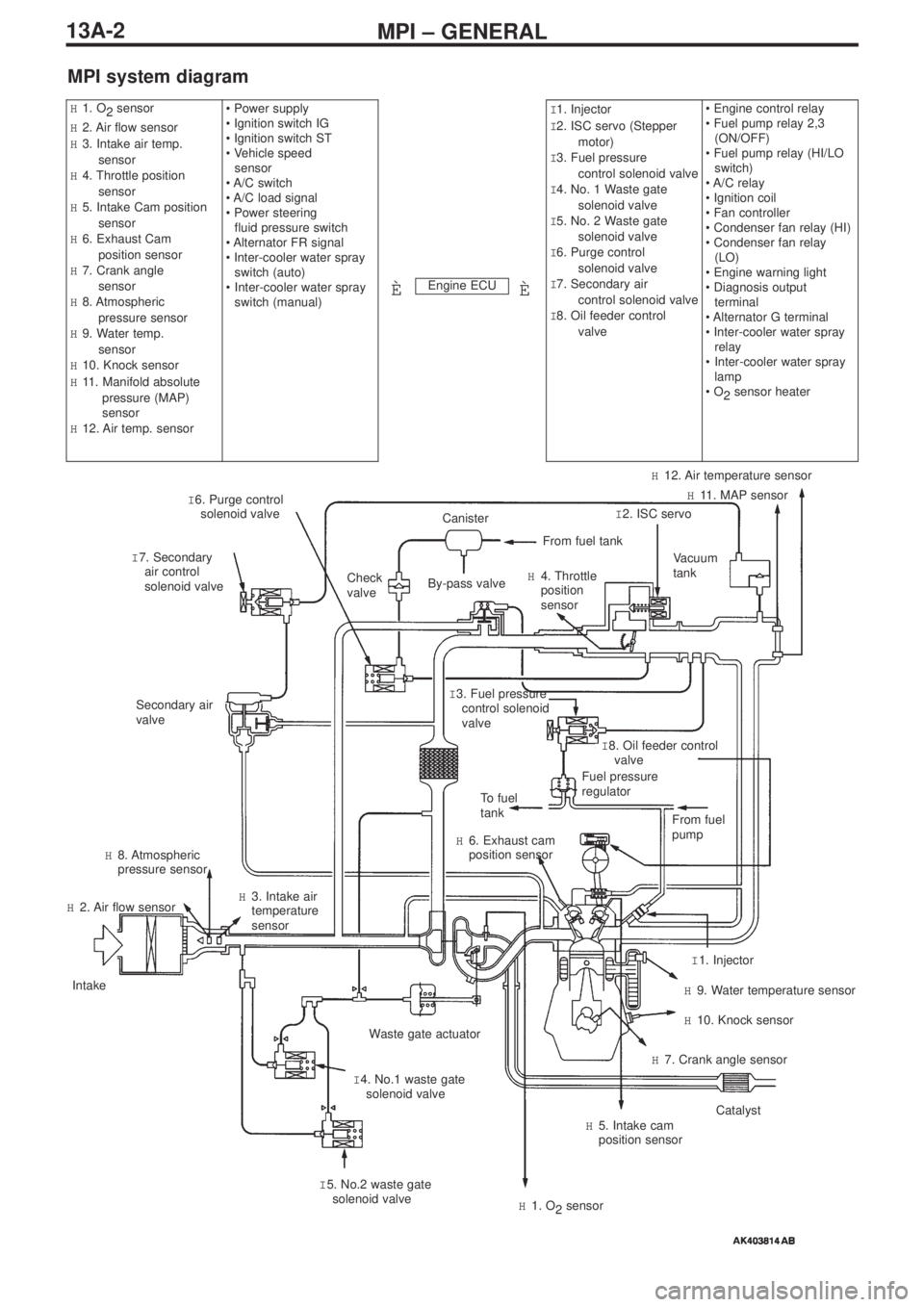
MPI – GENERAL13A-2
MPI system diagram
Engine ECU
H1. O
2 sensor
H2. Air flow sensor
H3. Intake air temp.
sensor
H4. Throttle position
sensor
H5. Intake Cam position
sensor
H6. Exhaust Cam
position sensor
H7. Crank angle
sensor
H8. Atmospheric
pressure sensor
H9. Water temp.
sensor
H10. Knock sensor
H11. Manifold absolute
pressure (MAP)
sensor
H12. Air temp. sensor• Power supply
• Ignition switch IG
• Ignition switch ST
• Vehicle speed
sensor
• A/C switch
• A/C load signal
• Power steering
fluid pressure switch
• Alternator FR signal
• Inter-cooler water spray
switch (auto)
•Inter-cooler water spray
switch (manual)I1. Injector
I2. ISC servo (Stepper
motor)
I3. Fuel pressure
control solenoid valve
I4. No. 1 Waste gate
solenoid valve
I5. No. 2 Waste gate
solenoid valve
I6. Purge control
solenoid valve
I7. Secondary air
control solenoid valve
I8. Oil feeder control
valve• Engine control relay
• Fuel pump relay 2,3
(ON/OFF)
• Fuel pump relay (HI/LO
switch)
• A/C relay
• Ignition coil
• Fan controller
• Condenser fan relay (HI)
• Condenser fan relay
(LO)
• Engine warning light
• Diagnosis output
terminal
• Alternator G terminal
• Inter-cooler water spray
relay
•Inter-cooler water spray
lamp
• O
2sensor heater
ÈÈ
I 6. Purge control
solenoid valve
I 7. Secondary
air control
solenoid valveCheck
valve
Secondary air
valve
To fuel
tank
H 6. Exhaust cam
position sensor
H 8. Atmospheric
pressure sensor
H 2. Air flow sensor
Intake
Waste gate actuator
I 4. No.1 waste gate
solenoid valve H 3. Intake air
temperature
sensor
I 5. No.2 waste gate
solenoid valve
H 1. O
2sensor
H 5. Intake cam
position sensorCatalyst
H 7. Crank angle sensor
H 10. Knock sensor
H 9. Water temperature sensor
I 1. Injector From fuel
pump
Fuel pressure
regulatorI 8. Oil feeder control
valve I 3. Fuel pressure
control solenoid
valve
Vacuum
tank
I 2. ISC servoH 11. MAP sensor
H 12. Air temperature sensor
H 4. Throttle
position
sensor
From fuel tank
Canister
By-pass valve
Page 43 of 364
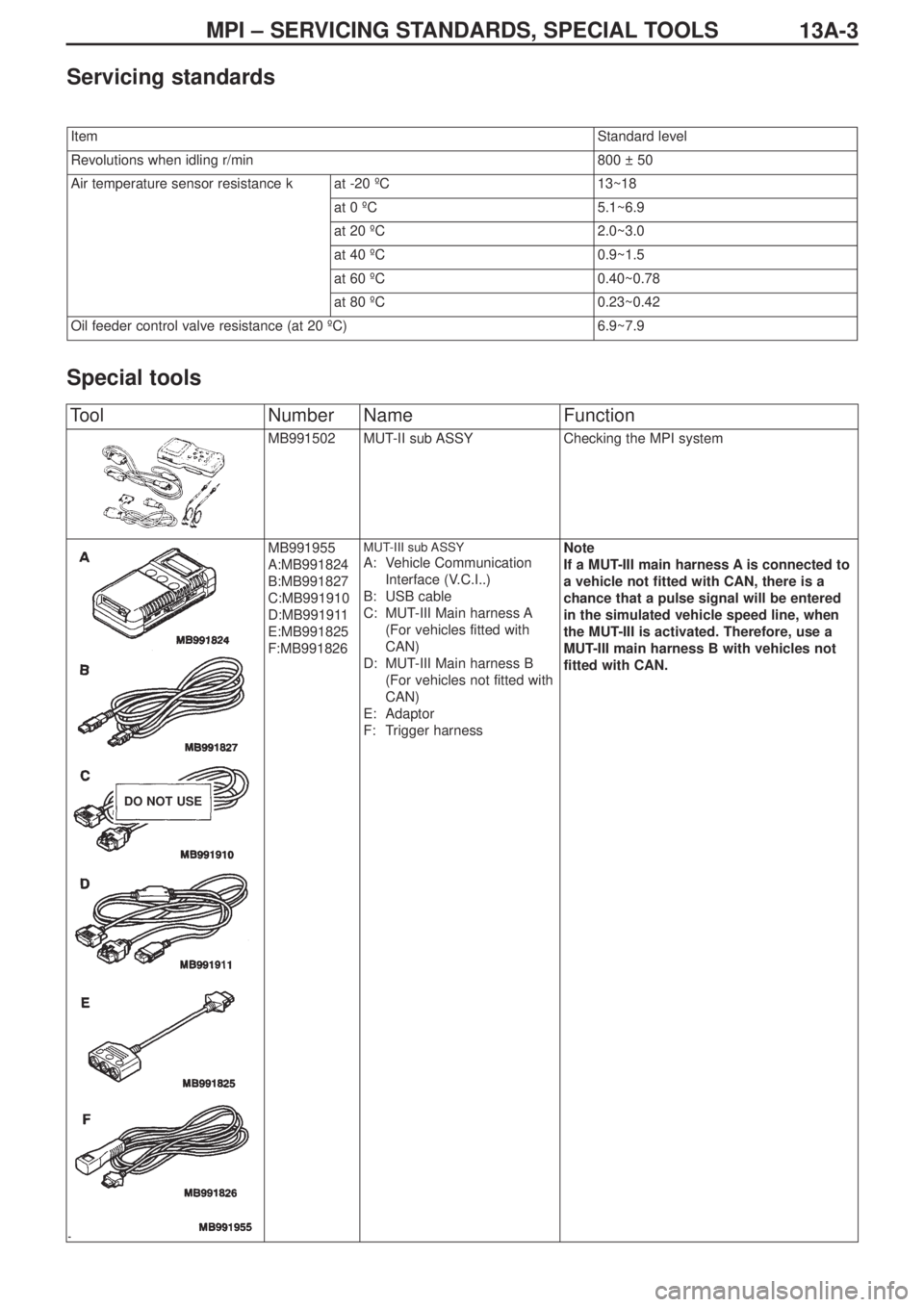
MPI – SERVICING STANDARDS, SPECIAL TOOLS
13A-3
Servicing standards
Special tools
ItemStandard level
Revolutions when idling r/min800 ± 50
Air temperature sensor resistance kΩat -20 ºC13~18
at 0 ºC5.1~6.9
at 20 ºC2.0~3.0
at 40 ºC0.9~1.5
at 60 ºC0.40~0.78
at 80 ºC0.23~0.42
Oil feeder control valve resistance (at 20 ºC) Ω6.9~7.9
ToolNumberNameFunction
MB991502MUT-II sub ASSYChecking the MPI system
MB991955
A:MB991824
B:MB991827
C:MB991910
D:MB991911
E:MB991825
F:MB991826MUT-III sub ASSY
A: Vehicle Communication
Interface (V.C.I..)
B: USB cable
C: MUT-III Main harness A
(For vehicles fitted with
CAN)
D: MUT-III Main harness B
(For vehicles not fitted with
CAN)
E: Adaptor
F: Trigger harnessNote
If a MUT-III main harness A is connected to
a vehicle not fitted with CAN, there is a
chance that a pulse signal will be entered
in the simulated vehicle speed line, when
the MUT-III is activated. Therefore, use a
MUT-III main harness B with vehicles not
fitted with CAN.
DO NOT USE
Page 44 of 364
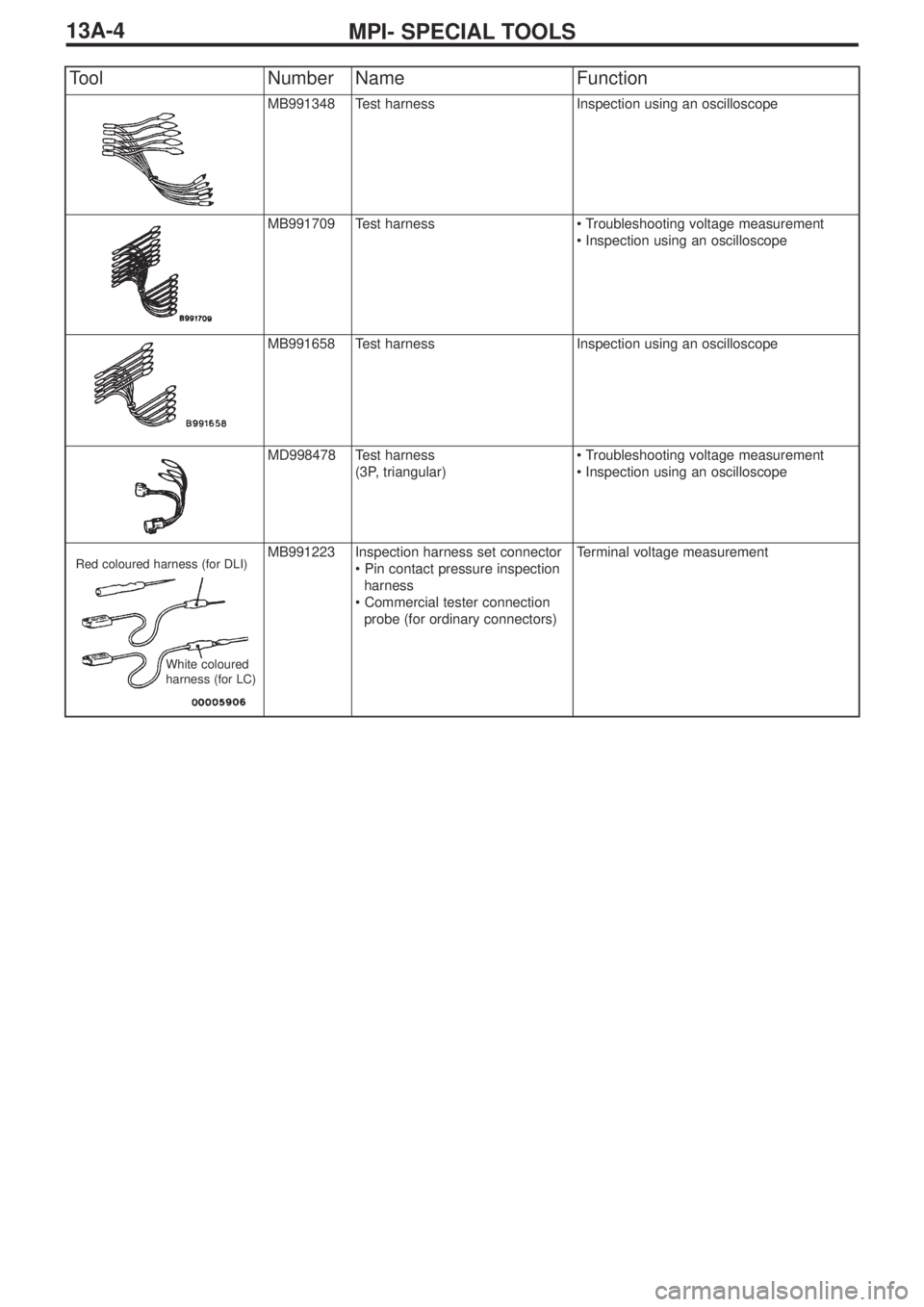
MPI- SPECIAL TOOLS13A-4
ToolNumberNameFunction
MB991348Test harness Inspection using an oscilloscope
MB991709Test harness • Troubleshooting voltage measurement
• Inspection using an oscilloscope
MB991658Test harnessInspection using an oscilloscope
MD998478Test harness
(3P, triangular)• Troubleshooting voltage measurement
• Inspection using an oscilloscope
MB991223Inspection harness set connector
• Pin contact pressure inspection
harness
• Commercial tester connection
probe (for ordinary connectors)Terminal voltage measurementRed coloured harness (for DLI)
White coloured
harness (for LC)
Page 45 of 364
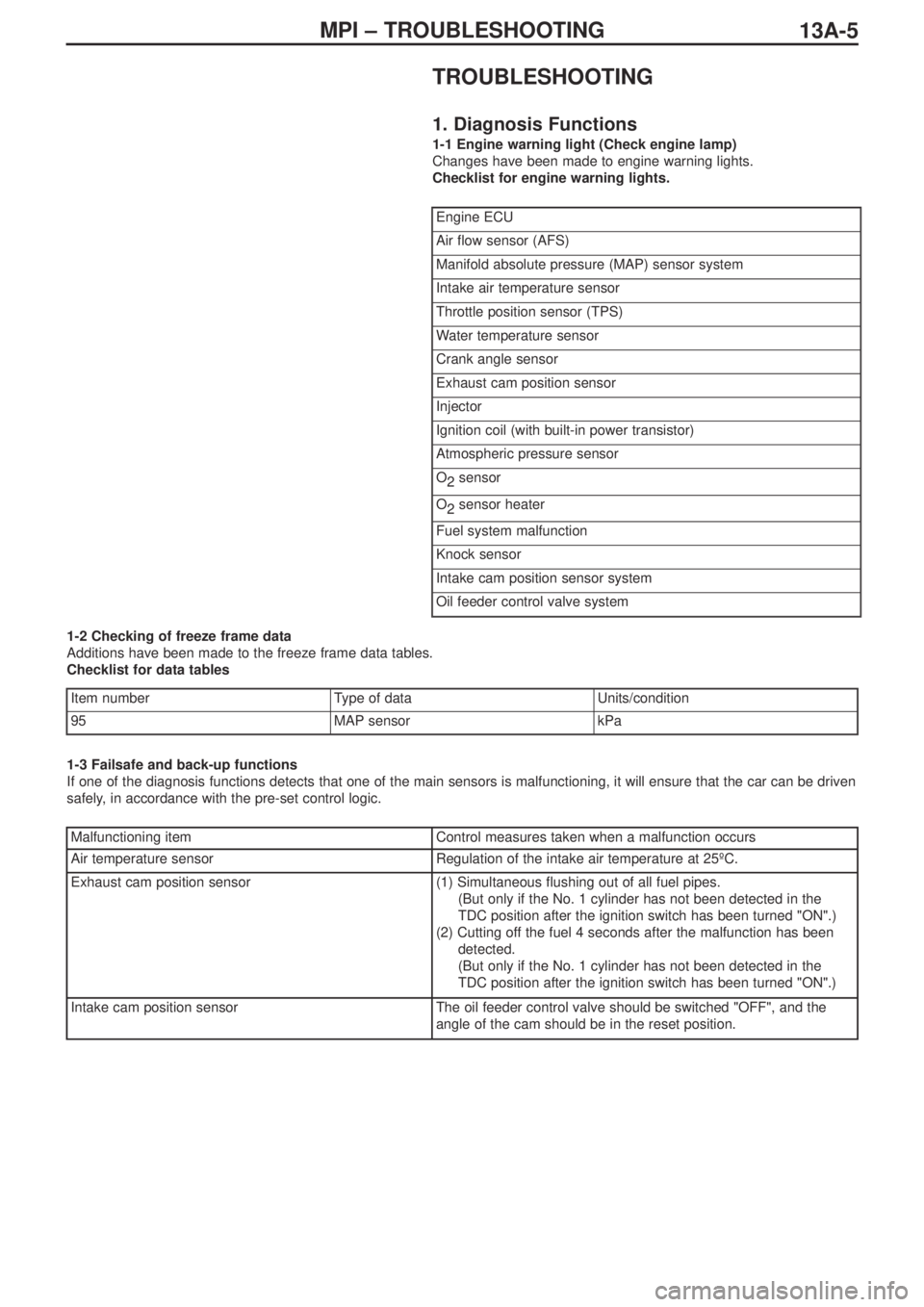
MPI – TROUBLESHOOTING
13A-5
TROUBLESHOOTING
1. Diagnosis Functions
1-1 Engine warning light (Check engine lamp)
Changes have been made to engine warning lights.
Checklist for engine warning lights.
1-2 Checking of freeze frame data
Additions have been made to the freeze frame data tables.
Checklist for data tables
1-3 Failsafe and back-up functions
If one of the diagnosis functions detects that one of the main sensors is malfunctioning, it will ensure that the car can be driven
safely, in accordance with the pre-set control logic.
Engine ECU
Air flow sensor (AFS)
Manifold absolute pressure (MAP) sensor system
Intake air temperature sensor
Throttle position sensor (TPS)
Water temperature sensor
Crank angle sensor
Exhaust cam position sensor
Injector
Ignition coil (with built-in power transistor)
Atmospheric pressure sensor
O
2sensor
O
2sensor heater
Fuel system malfunction
Knock sensor
Intake cam position sensor system
Oil feeder control valve system
Item numberType of data Units/condition
95MAP sensorkPa
Malfunctioning itemControl measures taken when a malfunction occurs
Air temperature sensorRegulation of the intake air temperature at 25ºC.
Exhaust cam position sensor(1) Simultaneous flushing out of all fuel pipes.
(But only if the No. 1 cylinder has not been detected in the
TDC position after the ignition switch has been turned "ON".)
(2) Cutting off the fuel 4 seconds after the malfunction has been
detected.
(But only if the No. 1 cylinder has not been detected in the
TDC position after the ignition switch has been turned "ON".)
Intake cam position sensorThe oil feeder control valve should be switched "OFF", and the
angle of the cam should be in the reset position.
Page 46 of 364

MPI- TROUBLESHOOTING13A-6
Code No.Diagnosis itemPage
P0105MAP sensor13A-7
P0340Exhaust cam position sensor system13A-9
P1012Intake cam position sensor system13A-11
P1021Oil feeder control valve system13A-13
P2226Atmospheric pressure system13A-14
2. Diagnosis code classification table
Page 47 of 364
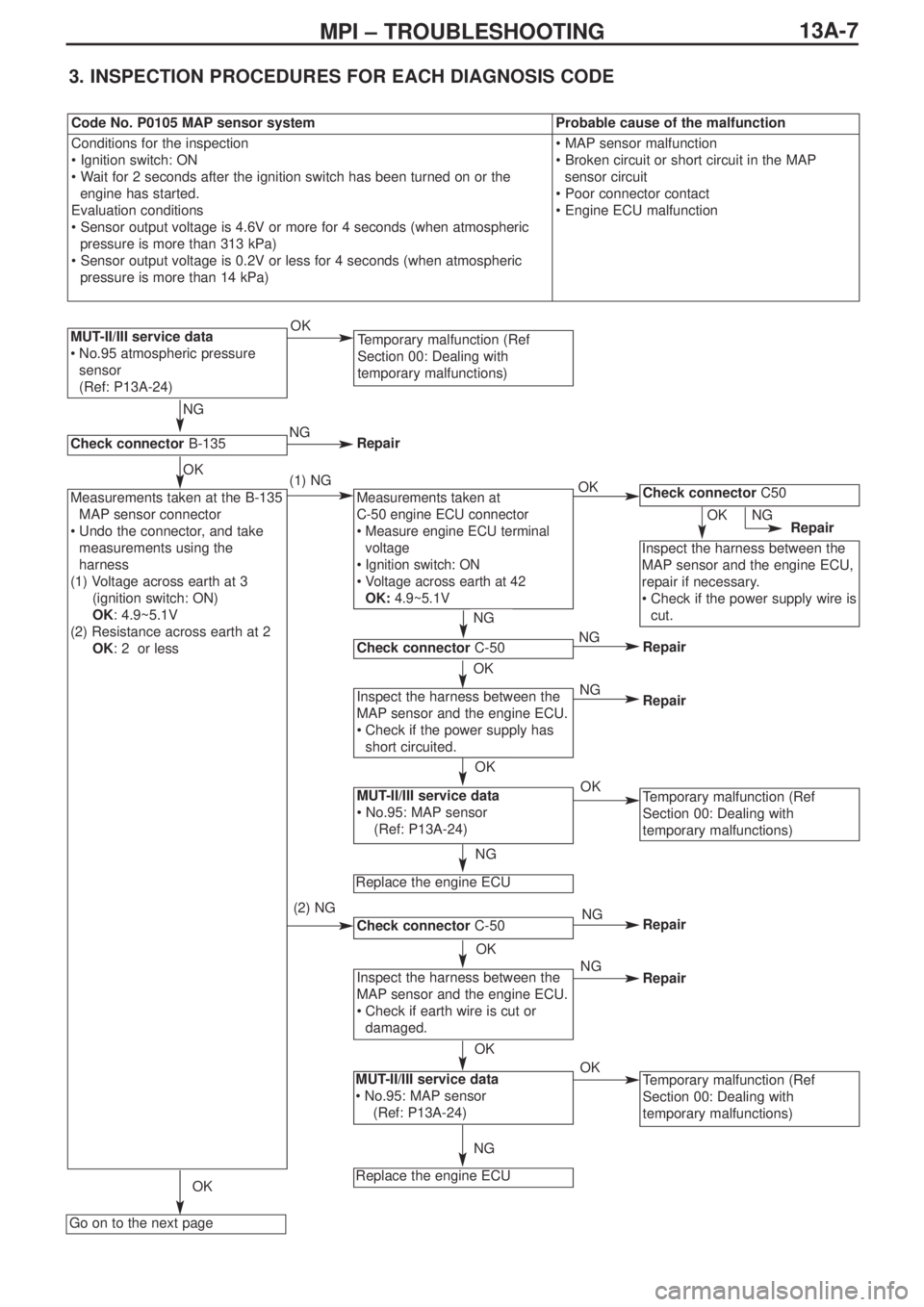
13A-7MPI – TROUBLESHOOTING
3. INSPECTION PROCEDURES FOR EACH DIAGNOSIS CODE
MUT-II/III service data
•No.95 atmospheric pressure
sensor
(Ref: P13A-24)
Go on to the next page
Measurements taken at
C-50 engine ECU connector
•Measure engine ECU terminal
voltage
•Ignition switch: ON
•Voltage across earth at 42
OK:4.9~5.1V
Check connectorC-50
Inspect the harness between the
MAP sensor and the engine ECU.
•Check if the power supply has
short circuited.
MUT-II/III service data
• No.95: MAP sensor
(Ref: P13A-24)
Replace the engine ECU
Check connectorC-50
Inspect the harness between the
MAP sensor and the engine ECU.
•Check if earth wire is cut or
damaged.
MUT-II/III service data
•No.95: MAP sensor
(Ref: P13A-24)
Replace the engine ECU
Check connectorC50
Inspect the harness between the
MAP sensor and the engine ECU,
repair if necessary.
•Check if the power supply wire is
cut.
Temporary malfunction (Ref
Section 00: Dealing with
temporary malfunctions)
Measurements taken at the B-135
MAP sensor connector
•Undo the connector, and take
measurements using the
harness
(1) Voltage across earth at 3
(ignition switch: ON)
OK: 4.9~5.1V
(2) Resistance across earth at 2
OK: 2Ω or less
Temporary malfunction (Ref
Section 00: Dealing with
temporary malfunctions)
Check connectorB-135
NG
(2) NG (1) NGOK
NG
OK
OK
Temporary malfunction (Ref
Section 00: Dealing with
temporary malfunctions)
NG
OK
NG
OK
OK
NGOK
NG
OK
NG
Repair
NG
OK
OK
NG
NG
OK
Repair
Repair
Repair
Repair
Repair
Code No. P0105 MAP sensor systemProbable cause of the malfunction
Conditions for the inspection
• Ignition switch: ON
• Wait for 2 seconds after the ignition switch has been turned on or the
engine has started.
Evaluation conditions
• Sensor output voltage is 4.6V or more for 4 seconds (when atmospheric
pressure is more than 313 kPa)
• Sensor output voltage is 0.2V or less for 4 seconds (when atmospheric
pressure is more than 14 kPa)• MAP sensor malfunction
• Broken circuit or short circuit in the MAP
sensor circuit
• Poor connector contact
• Engine ECU malfunction
Page 48 of 364
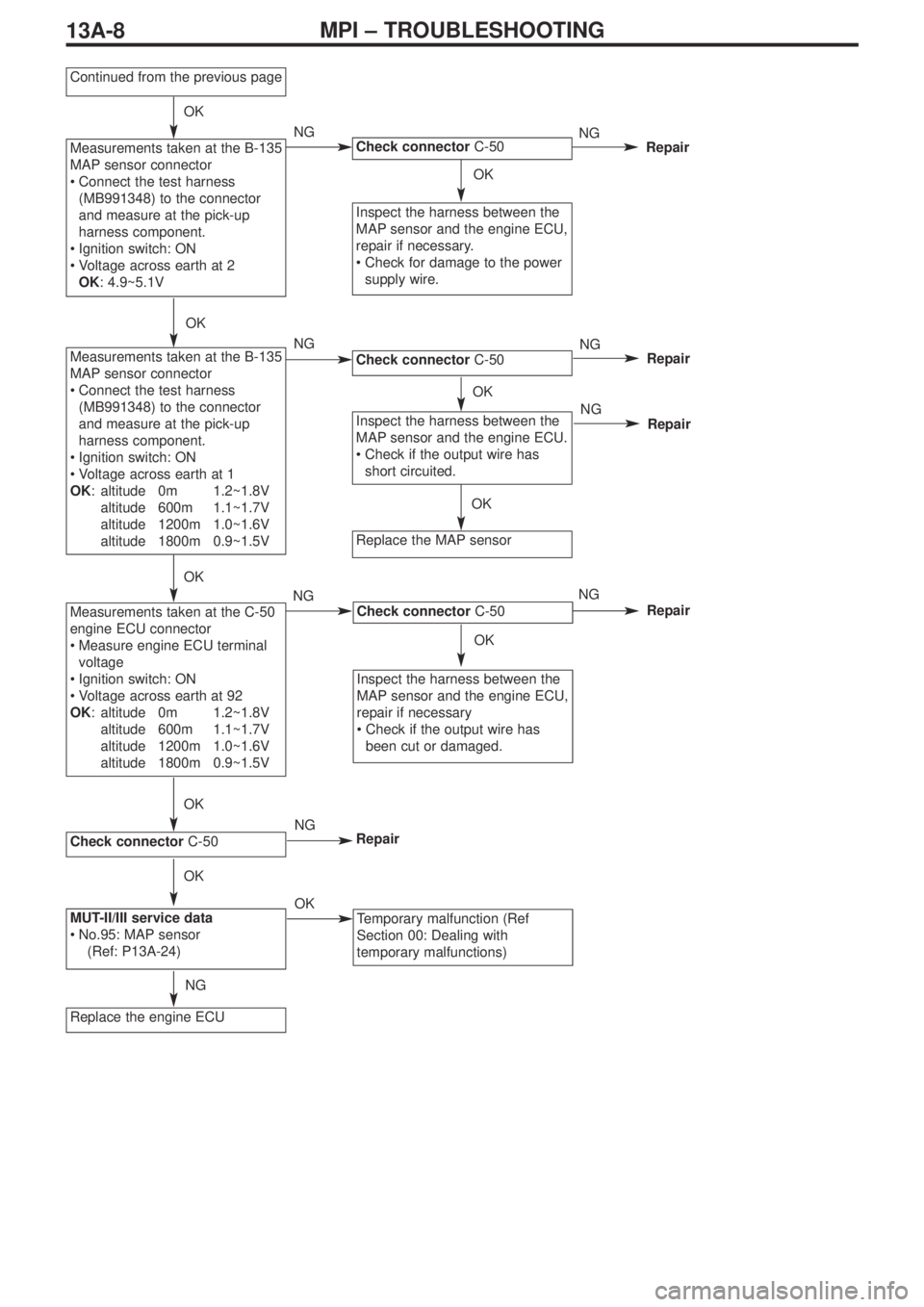
13A-8MPI – TROUBLESHOOTING
Continued from the previous page
Measurements taken at the B-135
MAP sensor connector
•Connect the test harness
(MB991348) to the connector
and measure at the pick-up
harness component.
•Ignition switch: ON
•Voltage across earth at 2
OK: 4.9~5.1V
Measurements taken at the B-135
MAP sensor connector
•Connect the test harness
(MB991348) to the connector
and measure at the pick-up
harness component.
•Ignition switch: ON
•Voltage across earth at 1
OK:altitude 0m 1.2~1.8V
altitude 600m 1.1~1.7V
altitude 1200m 1.0~1.6V
altitude 1800m 0.9~1.5V
Measurements taken at the C-50
engine ECU connector
•Measure engine ECU terminal
voltage
•Ignition switch: ON
•Voltage across earth at 92
OK:altitude 0m 1.2~1.8V
altitude 600m 1.1~1.7V
altitude 1200m 1.0~1.6V
altitude 1800m 0.9~1.5V
MUT-II/III service data
•No.95: MAP sensor
(Ref: P13A-24)
Replace the engine ECU
Check connectorC-50
Check connectorC-50
Inspect the harness between the
MAP sensor and the engine ECU,
repair if necessary.
•Check for damage to the power
supply wire.
Check connectorC-50
Inspect the harness between the
MAP sensor and the engine ECU.
•Check if the output wire has
short circuited.
Replace the MAP sensor
Check connectorC-50
Inspect the harness between the
MAP sensor and the engine ECU,
repair if necessary
•Check if the output wire has
been cut or damaged.
Temporary malfunction (Ref
Section 00: Dealing with
temporary malfunctions)
OK
OK
OK
OK
OK
NGRepair
OK
OK
OK
OK
NG
NGNG
NG
NG
OK
NG
Repair
NG
NG
Repair
Repair
Repair
Page 49 of 364
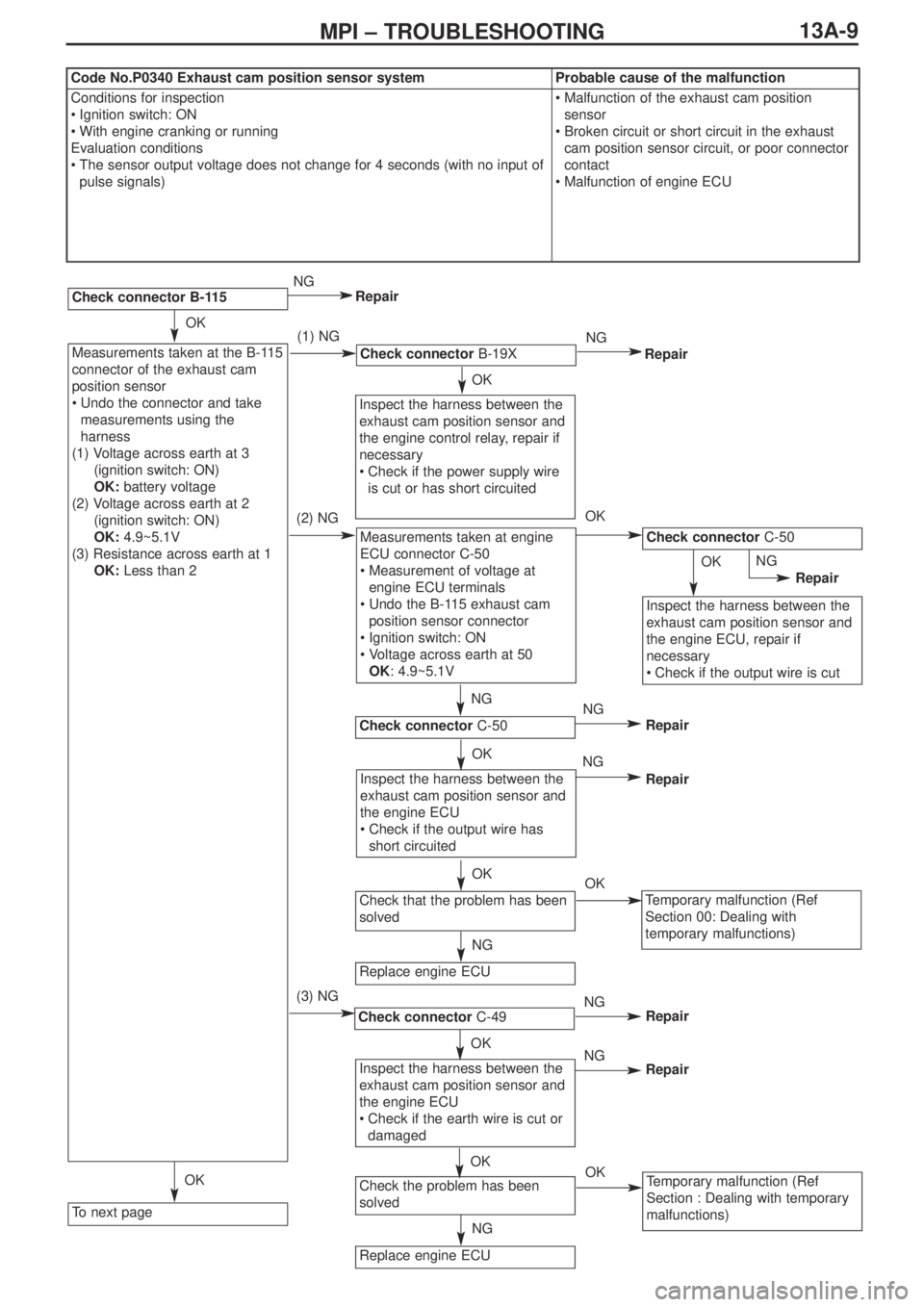
13A-9MPI – TROUBLESHOOTING
Check connector B-115
To next page
Check connectorB-19X
Measurements taken at engine
ECU connector C-50
•Measurement of voltage at
engine ECU terminals
•Undo the B-115 exhaust cam
position sensor connector
•Ignition switch: ON
•Voltage across earth at 50
OK: 4.9~5.1V
Inspect the harness between the
exhaust cam position sensor and
the engine control relay, repair if
necessary
•Check if the power supply wire
is cut or has short circuited
Inspect the harness between the
exhaust cam position sensor and
the engine ECU
•Check if the output wire has
short circuited
Check that the problem has been
solved
Check connectorC-50
Check connectorC-50
Inspect the harness between the
exhaust cam position sensor and
the engine ECU, repair if
necessary
•Check if the output wire is cut
Temporary malfunction (Ref
Section : Dealing with temporary
malfunctions)
Temporary malfunction (Ref
Section 00: Dealing with
temporary malfunctions)
Measurements taken at the B-115
connector of the exhaust cam
position sensor
•Undo the connector and take
measurements using the
harness
(1) Voltage across earth at 3
(ignition switch: ON)
OK:battery voltage
(2) Voltage across earth at 2
(ignition switch: ON)
OK:4.9~5.1V
(3) Resistance across earth at 1
OK:Less than 2Ω
NGRepair
Repair
OK
NG
OK
OK
NG
OK
NG
NG
OK
NGNG
NGOK
Inspect the harness between the
exhaust cam position sensor and
the engine ECU
•Check if the earth wire is cut or
damaged
Check connectorC-49
OK
OK
Replace engine ECU
NG
Check the problem has been
solved
Replace engine ECU
NG
OK
(1) NG
(2) NG
(3) NG
OK
OK
Repair
Repair
Repair
Repair
Repair
Code No.P0340 Exhaust cam position sensor systemProbable cause of the malfunction
Conditions for inspection
•Ignition switch: ON
•With engine cranking or running
Evaluation conditions
•The sensor output voltage does not change for 4 seconds (with no input of
pulse signals)•Malfunction of the exhaust cam position
sensor
•Broken circuit or short circuit in the exhaust
cam position sensor circuit, or poor connector
contact
•Malfunction of engine ECU
Page 50 of 364
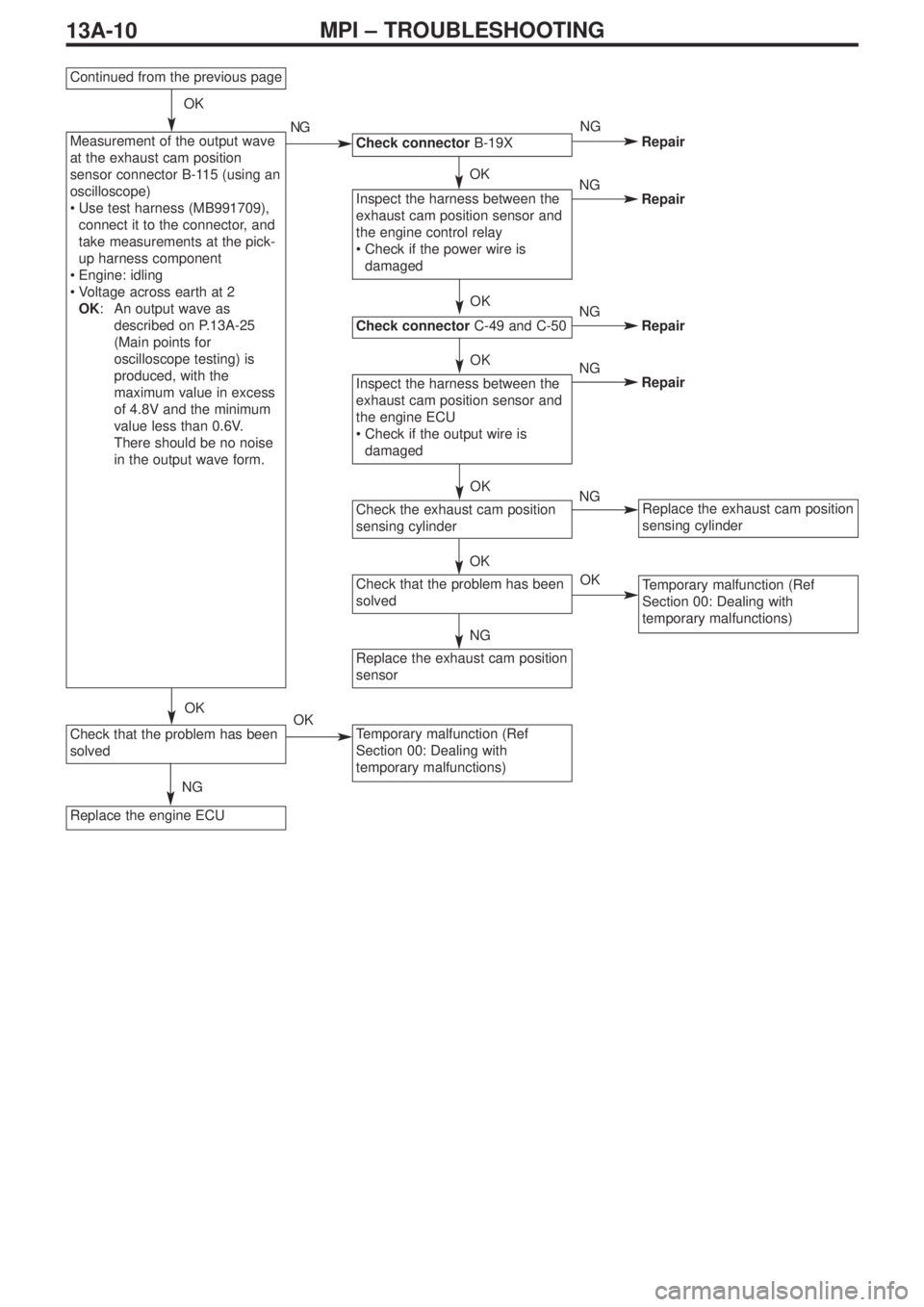
13A-10MPI – TROUBLESHOOTING
Continued from the previous page
Replace the engine ECU
Check connectorB-19X
Inspect the harness between the
exhaust cam position sensor and
the engine control relay
•Check if the power wire is
damaged
Check the exhaust cam position
sensing cylinder
Check connectorC-49 and C-50
Check that the problem has been
solved
Inspect the harness between the
exhaust cam position sensor and
the engine ECU
•Check if the output wire is
damaged
Temporary malfunction (Ref
Section 00: Dealing with
temporary malfunctions)
Measurement of the output wave
at the exhaust cam position
sensor connector B-115 (using an
oscilloscope)
•Use test harness (MB991709),
connect it to the connector, and
take measurements at the pick-
up harness component
•Engine: idling
•Voltage across earth at 2
OK: An output wave as
described on P.13A-25
(Main points for
oscilloscope testing) is
produced, with the
maximum value in excess
of 4.8V and the minimum
value less than 0.6V.
There should be no noise
in the output wave form.
Check that the problem has been
solved
OK
OK
NG
NG
OK
OK
OK
Replace the exhaust cam position
sensor
NG
OK
Replace the exhaust cam position
sensing cylinder
Temporary malfunction (Ref
Section 00: Dealing with
temporary malfunctions)
OK
OK
Repair
Repair
NG
NG
Repair NG
Repair NG
NG
OK